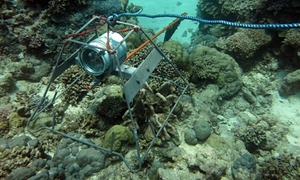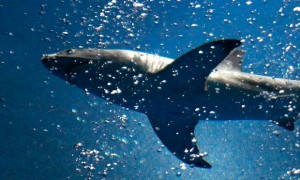The first ever global survey of sharks, rays and skates in coral reef environments using underwater cameras will begin in August.
The Global FinPrint survey uses technology called baited remote underwater video (Bruv) to take one hour of underwater footage, capturing marine life.
Bruvs, which are non-harmful, consist of fish bait with one or two GoPro cameras. They will be placed underwater at depths of 10-100m, in 400 locations across three key geographic regions: Indo-Pacific, tropical western Atlantic, and southern and eastern Africa and Indian Ocean islands.
The three year study, being led by scientists from Stony Brook, James Cook and Florida International Universities along with the Australian Institute of Marine Science (Aims), will include Australian locations in the Great Barrier Reef in Queensland, and the Scott and Ningaloo reefs of Western Australia.
One of the scientists on the project, Dr Mark Meekan from Aims, said existing shark data was piecemeal and this was the first time a comprehensive data set was being created by a global network of collaborators.
Not only the number and different types of sharks and rays are to be counted, but also fish and – where possible – the size and maturity of the animals.
Sharks were chosen for the study as they were “uniquely vulnerable” to human pressures, Meekan said. Compared to fish, female sharks give birth to relatively few pups, and these pups take a long time to reach maturity.
They are also the apex predators in marine environments, and their very presence alters and regulates the food chain. “When you remove them, things go out of whack,” he said.
A quarter of shark and ray species from around the world are facing an elevated threat of extinction, with an estimated 100m sharks killed each year. Meekan said the endangerment was linked to the rise of China’s middle class, where shark fin soup was considered a symbol of wealth.
“Better management of sharks and rays starts with better information about where and when they occur, so that we can target mitigation and protect the areas that are critical habitats,” he said.
The team was particularly interested in observing pristine marine systems with minimal human impacts. “They provide us with baselines for what we should be aiming for.”
Meekan said the survey would help to answer how marine ecosystems were affected in the absence of sharks, of which there was little understanding. “Sharks have been very difficult to work on in the past,” he said.
“If you’re a researcher going to work on coral reef, small fishes are territorial and easier to manipulate and experiment on than a reef shark, which is large, highly mobile and acutely dangerous to work with.”
The findings of the study will be published on an open-access database platform. Meekan said sharing data was less common in biology and ecology, especially compared with other scientific fields such as genetics.
He said part of the reason was that their field work tended to be resource-intensive and costly. But added: “no one hoards data anymore – biologists and ecologists are the last holdouts – and it’s hurting our field”.
Sharing would allow researchers, policy makers, governments and environmentalists to make use of the database and inform conservation priorities.








